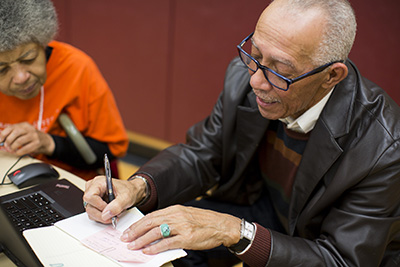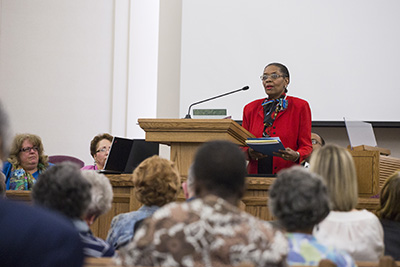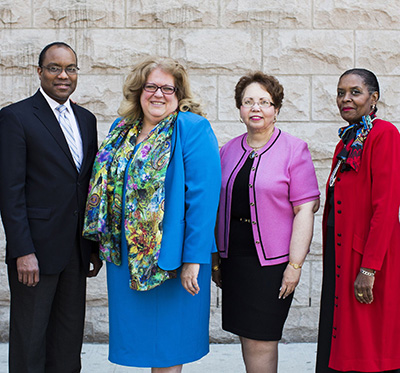African American Genealogy Conference Inspires in Harlem
Contributed By By Janet Peterson, Church News staff writer

Attendees engage in conversation at the African American Genealogy Conference in Harlem May 3, 2014.
Article Highlights
- Use caution and courtesy in supplying data and making suggestions or corrections.
- Enter family data correctly to make it more shareable and to reduce duplication.
- Developing a strategic research plan to find ancestors through maps, gazetteers, and migration routes.
Related Links
“One effective way to retain [the] youth is to involve them in family history,” said Ahmad S. Corbitt, director of the Church’s New York Office of Public and International Affairs, in speaking at the African American Genealogy Conference on May 3, 2014.
He saw in his own family this turning of “the heart of the fathers to the children, and the heart of the children to their fathers” (Malachi 4:6).
Last year, Brother Corbitt's 24-year-old daughter enthusiastically told him she had found her great-grandfather in a census. He said, “It was as if she had met him herself.” Brother Corbitt felt this experience also brought them closer as father and daughter.
Drawing more than 200 participants, the conference was cosponsored by the Afro-American Historical and Genealogical Society and the Church and was held at the Harlem meetinghouse. Sharon Wilkins, president of the New York chapter of the AAHGS, gave brief introductory remarks noting the “tremendous spirit, tremendous ingenuity, and tremendous history” of the occasion.
The session speakers included Dr. Marion T. Lane of Doylestown, Pennsylvania, and Mary H. Slawson of Provo, Utah.
Although Dr. Lane’s father often told her she had ancestors who served in the Revolutionary and Civil Wars, it wasn't until 2006 when she watched a PBS documentary, African American Lives, that she began to research her family roots. The show featured her family, the Browns of Charles City County, Virginia, as a free black family dating back to colonial times. Her curiosity was piqued.
Through her research of wills, pension records, the Charles City County Register of Negroes and Mulattoes, and the Revolutionary War roster, Dr. Lane discovered that her fourth great-grandfather, Isaac Brown, was a fourth-generation descendant of blacks who had been brought to the Virginia colonies as indentured servants, not slaves. Isaac enlisted in the Continental Army in 1777, serving as a sergeant under George Washington at Valley Forge and fighting in the battles of Guilford Courthouse, Siege of Fort Ninety-six, and Eutaw Springs. Dr. Lane feels great pride in her patriotic heritage and has shared Isaac’s story with family members and many others.

An attendee works on his genealogy at the African American Genealogy Conference. Photo by Mark Louis Weinberg.

Attendees at the African American Genealogy Conference in Harlem May 3. Photo by Mark Louis Weinberg.

A speaker addresses the audience at the African American Genealogy Conference in Harlem May 3. Photo by Mark Louis Weinberg.

Presenters from the African American Genealogy Conference May 3. Photo by Mark Louis Weinberg.
Now retired as a public school educator, administrator, and adjunct professor, Dr. Lane serves on the Board of the Friends of Valley Forge National Historical Park and as national president of the Society of Descendants of Washington’s Army at Valley Forge, and she is one of the few African American members of the Daughters of the American Revolution. Because of her efforts, a monument honoring the 26 African American patriots from Charles City County was placed in an area cemetery.
Mary Slawson has been involved in genealogical research and has taught for more than 40 years and is a member of the Association of Professional Genealogists, Association of Personal Historians, the New England History Society, and cohost of the radio show Relatively Speaking. She is the author of a style guide for family history and serves as the Irish medieval specialist for the Salt Lake City Family History Library.
“The purpose of family history work is to bring families together, not to drive them apart,” she said during her address, titled “Doing Your Family History with Style.” She emphasized how the Internet has brought distant family members together, but she also cautioned using courtesy in supplying data and making suggestions or corrections—to “avoid being shrill.”
She noted that entering family data correctly will lead to greater success in online research. Appropriately entered data can then be shared more easily, which reduces duplication of records from 80 percent to 4 percent.
In a second presentation, “Tips for Making a Family History Interview Better,” Sister Slawson defined an oral history as “a living person’s testimony about their own experiences.” She discussed how to prepare for and to conduct one, types of questions to ask, a suggested equipment checklist, and that the interviewer “should get out of the way” and let the person being interviewed do the talking.
She also mentioned the importance of developing a strategic research plan to find ancestors through maps, gazetteers, migration routes, and learning what kinds of records existed during an ancestor’s time.
Prior to and after the conference, participants were invited to “Getting Started on Genealogy,” a workshop hosted by family history missionaries and ward specialists to answer questions and offer computer help.
